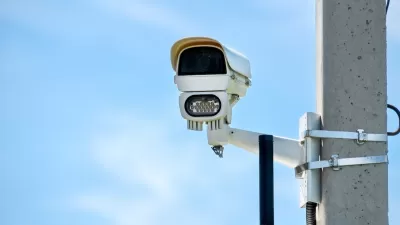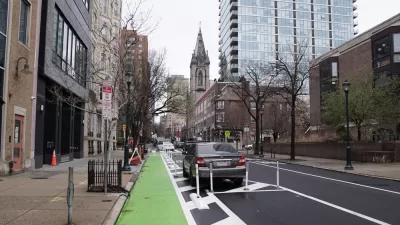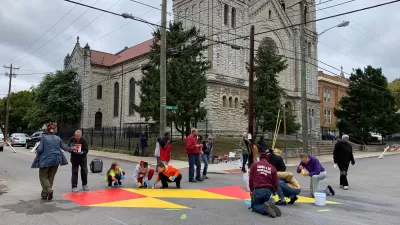Part of a larger safety and beautification plan, the mural is designed to slow down drivers and bring a 'sense of hope' to the neighborhood.

A Philadelphia neighborhood has a new mural that supporters "hope will improve pedestrian safety, help bring business to the stores on the corridor and, as Somaly Osteen puts it, 'create a sense of hope.'" According to Juliana Feliciano Reyes, "[t]he mural is part of a larger beautification and safety effort run by SEAMAAC [Southeast Asian Mutual Assistance Association Coalition] for the neighborhood" and "is intended to make the intersection safer by attracting the attention of drivers, who will then slow down and stop, instead of rolling through stop signs." The coalition hopes this will improve safety for children walking to nearby schools and instill a sense of pride in the community.
"Murals aiming to slow traffic and increase pedestrian safety have been installed in cities such as St. Paul, Minn.; Baltimore; and Philadelphia — the South of South Street Neighbors Association worked with Mural Arts to install one in Graduate Hospital this year. Philadelphia had a higher rate of traffic-related deaths than New York City, Chicago, and San Francisco, according to 2018 data from the National Highway Traffic Safety Administration." Meanwhile, "Neighborhoods that are largely home to people of color and those living in poverty are more likely to experience these accidents."

Alabama: Trump Terminates Settlements for Black Communities Harmed By Raw Sewage
Trump deemed the landmark civil rights agreement “illegal DEI and environmental justice policy.”

Planetizen Federal Action Tracker
A weekly monitor of how Trump’s orders and actions are impacting planners and planning in America.

The 120 Year Old Tiny Home Villages That Sheltered San Francisco’s Earthquake Refugees
More than a century ago, San Francisco mobilized to house thousands of residents displaced by the 1906 earthquake. Could their strategy offer a model for the present?

In Both Crashes and Crime, Public Transportation is Far Safer than Driving
Contrary to popular assumptions, public transportation has far lower crash and crime rates than automobile travel. For safer communities, improve and encourage transit travel.

Report: Zoning Reforms Should Complement Nashville’s Ambitious Transit Plan
Without reform, restrictive zoning codes will limit the impact of the city’s planned transit expansion and could exclude some of the residents who depend on transit the most.

Judge Orders Release of Frozen IRA, IIJA Funding
The decision is a victory for environmental groups who charged that freezing funds for critical infrastructure and disaster response programs caused “real and irreparable harm” to communities.
Urban Design for Planners 1: Software Tools
This six-course series explores essential urban design concepts using open source software and equips planners with the tools they need to participate fully in the urban design process.
Planning for Universal Design
Learn the tools for implementing Universal Design in planning regulations.
Clanton & Associates, Inc.
Jessamine County Fiscal Court
Institute for Housing and Urban Development Studies (IHS)
City of Grandview
Harvard GSD Executive Education
Toledo-Lucas County Plan Commissions
Salt Lake City
NYU Wagner Graduate School of Public Service





























